|
Following
Gandhi's Path - Part 4
Gandhi
in Delhi
"India cannot
possibly make more progress leaning only on the spirit of
Gandhi, but neither can it do so without it".
- Jan Oberg, director of TFF.
Gandhi was murdered in New Delhi on Friday, the 30th
of January, 1948. The next day his body was carried on a
gun-carriage to the river Jamuna to be cremated, escorted
by 4,000 soldiers, one thousand air force soldiers, and
as many policemen. It was not a mere coincidence that the
regime of the day "honoured" the country's father of
non-violence in this manner. I also think that there are
obvious connections between this and the India of our
days, with all its corruption, elitism and its nuclear
weapons.
I happened to arrive in Delhi on the 29th of January
and I went to Rajghat, which is by the Jamuna river, to
see the monument, Gandhi Samadhi, a giant cube in black
marble with an eternal flame and an inscription of
Gandhi's last words: "He Ram!" - Oh God!
The cube is lying in the middle of an enormous lawn.
It is an aesthetically cold memorial, pompous, and in
inverse proportion to Gandhi's modesty.
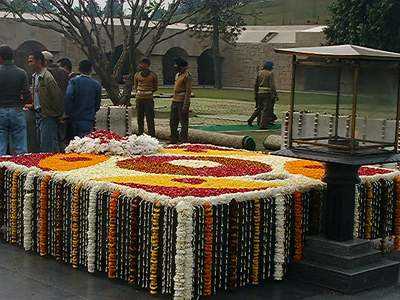
Photo Jan Öberg, © TFF
2001
The Gandhi Memorial -"Samadhi" -
at Rajghat, Delhi
A guard on duty told me that the place was now closed
and would not open until the next day. When I returned,
the memorial looked more like a battlefield. Soldiers had
rolled out enormous green carpets. I saw a mess of chairs
all over and flowerpots being carried to and fro.
Already during my second day in India I realised that
Gandhi is actually a sort of persona non grata, who is
impossible to ignore, today, just as in 1948.
The elite celebrated Gandhi first, in the morning, and
then it was time to let in the crowd. The ideals Gandhi
represented do not make much difference these days in the
official politics of India; however, I was happy to see
that so many people came there that day, 53 years after
he died, lots of ordinary people from Delhi, thousands of
plainly clothed peasants, old and young.
Gandhi is dead! Long live Gandhi!
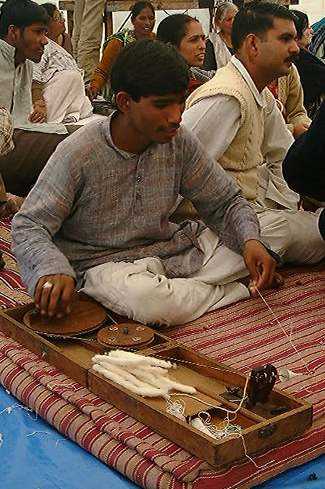
Photo Jan Öberg, © TFF
2001
Young people learning how to
spin
Mr and Mrs
Honda
On my way out I came across Mr Honda and his wife.
That day they were selling Gandhi-literature, but
otherwise they run a day-care home for children from the
slums. Honda is a tall, pot-bellied and waddling man in a
khadi and sandals.
"The future of India is still the spinning-wheel", he
says with complete conviction. "Look at them! These are
our children who are just learning how to spin and sew
their own clothes. We have spent all these years saving
them from the slums, now they have an education and can
make their own living. These boys will not be alcoholics
as many of their fathers were and the girls will not be
prostitutes. We give them decent food as well".
I can imagine how it works in practice. Of course
India cannot possibly continue to make progress leaning
only on the spirit of Gandhi and the use of
spinning-wheels, but I begin to understand that they
can't make progress without them either.
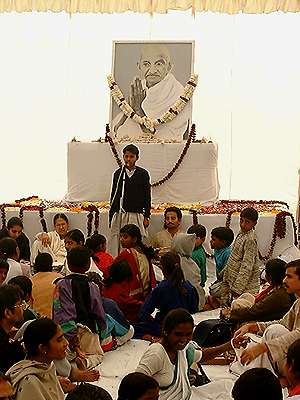
Photo Jan Öberg, © TFF
2001
Young people carrying on
discussions on Gandhi Day
Gandhi Darshan and
the National Memorial Museum
Past Mahatma Gandhi Road and a couple of hundred
metres down on Powerhouse Road you can find Gandhi
Darshan (International Centre for Gandhian Studies and
Research, http://www.gandhismriti.org),
a giant complex of plain buildings housing exhibition
halls, workshops, institutions of education, a museum, a
research institute, sculptures and handicraft. All is
presented with the intent to preserve Gandhi's way of
thinking and make his perspective relevant to even
present day society.
On Gandhi Road you find also Gandhi Book House, an
extraordinary bookstore, and the Gandhi National Memorial
Museum with its exceptional collections and research
library.
I went to see a temporary, quite unique, exposition
about Kasturba, who got married to Gandhi at the age of
13 and lived with him throughout her life until her death
in Puma in 1943. The old pictures show a strong woman who
had to face a little of everything, including Gandhi's
decision to abstain from sex. I was able also to read her
sorrowful and wise letter to one of their sons, when he,
whom Gandhi treated as a pariah, was arrested drunk and
disgraced the whole family in public.
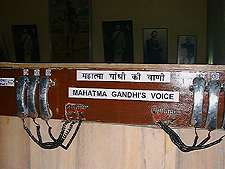
Photo Jan Öberg, © TFF
2001
You can also listen to Gandhi in
the museum
There is also a permanent exhibition that shows
photographs, letters, personal belongings and a replica
of Gandhi's workroom. The Memory Hall focuses on his last
days, the murder and the funeral. You can see the watch
he was wearing, as well as the bullets that killed him,
his blood-stained clothes and the urns from which his
ashes were spread over India. In the small, dusty
Literature Centre behind the museum you can also buy a
multimedia CD which contains a 30-minute long film, 550
photographs, 15 minutes of Gandhi's voice, and Gandhi's
entire literary output of more than 50,000 indexed pages,
as well as special sections where the fundamental
principles and the most important events in Gandhi's and
India's history are illustrated. ("Mahatma Gandhi", US
$60).
The museum is located in a small park beautifully
surrounded by big trees and sculptures of Gandhi. Indoors
everything is dusty and yellowed with age. All of the
objects are kept in old wooden showcases and the books
are standing or lying on big grey metal bookshelves as in
a mechanical workshop. But the whole thing feels
exceptionally genuine. It's like being there at the time
when it all happened.
Gandhi's mode of thinking, the philosophy of
non-violence, and his economic theory must nevertheless
be "translated" in order to meet the needs and challenges
of the present day. Gandhi must not become a museum,
because then all that he stood for would die.
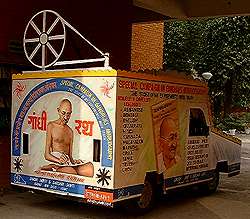
Photo Jan Öberg, © TFF
2001
Gandhi Darshan spreads the
message
India's problem
with Gandhi
During my journey in India, I began to realize what
problems Indians might have in relation to Gandhi. He
died without a fortune, title, property, academic
honours, and, of course, without a Nobel Prize, in his
private capacity. He is just too great and too difficult
to live up to. It is well-nigh impossible to become a
"Gandhian". But it is entirely possible to turn him into
a museum exhibit, honour him once a year, and otherwise
just forget about him.
Of course, Gandhi has no Mecca of his own. Still, he
feels present everywhere, not least in the hearts of the
Indian people. But those interested who reach Delhi start
naturally with these institutions. Each of them gave me
an unforgettable experience. However, Birla House or
Gandhi Smriti, where Gandhi spent his last 144 days in
life and was shot, remains the most important for me. In
my next article I'll tell you why. Until then, please
have a look at
http://www.transnational.org/forum/Nonviolence/Nonviolence.html
Translated by Alice
Moncada
Translation edited by Sara E. Ellis
Other
articles about India, "Following Gandhi's Path" and
picture galleries
©
TFF 2002

Tell a friend about this article
Send to:
From:
Message and your name
|